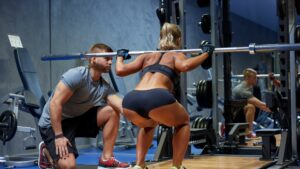Hey there, fitness enthusiasts! If you’ve ever wondered how much you should be squatting at the age of 35, you’re not alone.
Squats are a fantastic exercise, but understanding what’s considered a reasonable goal can be a bit tricky.
In this blog post, we’re diving into the world of squatting for 35-year-olds. We’ll explore various factors that influence your squatting ability, from training experience to genetics, and provide you with practical insights to set your own personal benchmarks. So, let’s get ready to squat and uncover what’s right for you!
Understanding the weight you’re supposed to be Squatting at 35 Years Old: Why and how: Explained).
While you should consider your current fitness first for there is no particular amount of weight you be squatting at a particular age. A healthy 35-year-old with a reasonable amount of training experience and no major limitations might aim for a squat that’s 1 to 2 times their body weight for a few repetitions.
The amount you should be able to squat at the age of 35 can vary widely depending on several factors, including your fitness level, training history, genetics, and overall health. There’s no one-size-fits-all answer to this question, but here I provide some general guidelines to help you understand what might be achievable:
Training Experience: Your squatting ability will depend on how long you’ve been training and the consistency of your workouts. If you’re relatively new to squatting, you may not lift as much weight as someone with years of experience.
Body Weight: Your body weight plays a significant role in how much you can squat. Heavier individuals may be able to lift more weight in absolute terms, but it’s also essential to consider your body weight relative to your strength.
Gender: Men, on average, tend to have higher squat strength compared to women. However, this is a generalization, and individual variation is significant.
Goals: Your squatting goals can influence your performance. Are you squatting for general fitness, muscle building, powerlifting, or a specific sport? Your training program will differ based on your objectives.
Injuries or Limitations: Any past injuries or physical limitations can impact your squatting ability. It’s crucial to perform squats with proper form to prevent injuries.
Genetics: Genetics can also play a role in your squatting potential. Some people may naturally have a greater predisposition for strength and muscle development.
Nutrition and Recovery: Proper nutrition and recovery are essential for strength gains. If you’re not fueling your body adequately or not allowing enough time for recovery, it can hinder your progress.
As a rough guideline, a healthy 35-year-old with a reasonable amount of training experience and no major limitations might aim for a squat that’s 1 to 2 times their body weight for a few repetitions.
However, this is just a general benchmark, and it can vary widely. It’s essential to focus on your personal progress and not compare yourself to others, as everyone has their unique strengths and limitations.
To improve your squatting strength, consider working with a qualified fitness trainer or coach who can design a customized training program tailored to your goals and abilities.
They can also help you with proper technique and form, which is crucial for both performance and injury prevention.

Further Explanations.
Let’s delve deeper, let me explain these points mentioned further.
First, let’s delve deeper into how training experience and body weight impact your squatting ability:
1. Training Experience.
Beginners:
If you’re relatively new to squatting or strength training in general, your squatting ability is likely to be lower compared to someone who has been training for several years.
This is because your muscles and nervous system are still adapting to the movement, and you may not have developed the neuromuscular coordination and muscle strength required to lift heavier weights. Beginners often make significant initial gains in strength as they adapt to training.
Intermediate and Advanced:
As you gain experience and consistently train, your squatting strength will typically improve. Intermediate lifters may be able to lift a moderate amount of weight, while advanced lifters can often lift significantly more.
This improvement comes from factors such as increased muscle mass, improved technique, and enhanced neuromuscular efficiency.
2. Body Weight.
Absolute Strength:
Heavier individuals often have an advantage in terms of absolute strength, meaning they can lift more weight in total pounds or kilograms.
This is because they have more mass to generate force. It’s not uncommon for heavier individuals to have higher squat maxes in terms of the actual weight on the barbell.
Relative Strength:
Relative strength, on the other hand, considers your squat strength in relation to your body weight. It’s a measure of how strong you are relative to your size.
Lighter individuals may have higher relative strength because they are lifting a significant percentage of their body weight.
To illustrate the concept of relative strength, let’s consider two individuals:
Person A weighs 200 pounds (90 kg) and can squat 300 pounds (136 kg).
Their absolute squat strength: 300 pounds (136 kg).
Their relative squat strength: 1.5 (300/200), meaning they can squat 1.5 times their body weight.
Person B weighs 150 pounds (68 kg) and can squat 225 pounds (102 kg).
Their absolute squat strength: 225 pounds (102 kg).
Their relative squat strength: 1.5 (225/150), also squatting 1.5 times their body weight.
In this example, both individuals have the same relative squat strength, even though Person A lifts more weight in absolute terms.
Ultimately, what matters most is setting and working towards your personal goals. Whether you aim to increase your absolute strength, relative strength, or both, a well-structured training program, proper nutrition, and consistency are key factors in achieving your squatting goals. It’s also crucial to prioritize safety and maintain good form to prevent injuries as you progress in your squatting journey.
let’s explore how gender and goals can impact squatting performance:
3. Gender.
Generalization:
On average, men tend to have higher squat strength compared to women. This is partly due to physiological differences, such as greater muscle mass and testosterone levels in men, which contribute to increased muscle and strength development.
Men often have a higher proportion of fast-twitch muscle fibers, which are conducive to explosive strength and power, like what’s required for squats.
Individual Variation:
It’s crucial to emphasize that these are general trends, and individual variation is significant. There are many women who can out-squat men, and numerous factors, including genetics, training history, and dedication, play a role.
Additionally, women may have certain biomechanical advantages in squatting due to differences in hip and pelvic anatomy.
Training Effect:
Regardless of gender, a consistent and well-structured training program can lead to significant improvements in squat strength for both men and women.
Progressive overload, proper technique, and targeted training can help individuals maximize their squatting potential, regardless of their starting point.

3. Goals.
General Fitness:
If your primary goal is general fitness and overall health, your squatting performance may not be measured solely in terms of how much weight you can lift.
Instead, you might focus on squats as a functional movement to improve lower body strength, stability, and mobility.
In this case, your squatting ability is more about maintaining a healthy range of motion and preventing injury.
Muscle Building:
For those aiming to build muscle (hypertrophy), squatting can be a valuable exercise.
Here, the focus might be on moderate to high-repetition sets with a moderate weight to stimulate muscle growth. Proper form and time under tension are crucial for hypertrophy-focused squatting.
Powerlifting:
Powerlifters have a specific goal: to lift as much weight as possible in three lifts, one of which is the squat.
In powerlifting, the squat is performed with strict competition standards, and the emphasis is on maximal strength. Training for powerlifting typically involves lower reps with very heavy weights.
Sport-Specific Training:
Athletes in various sports, such as Olympic weightlifting or track and field, may incorporate squats into their training for sport-specific reasons.
The focus here is on developing explosive power, which may require a combination of heavy squats and plyometric exercises.
Your squatting program should align with your goals. If you’re uncertain about how to structure your training, working with a qualified fitness trainer or coach can help you design a program tailored to your objectives and provide guidance on proper technique. Remember that regardless of your goals, safety and good form should always be a priority when performing squats to minimize the risk of injury.
Let’s explore how injuries or limitations and genetics can influence your squatting ability:
4. Injuries or Limitations.
Past Injuries:
Any previous injuries, especially those related to the lower back, knees, hips, or ankles, can significantly impact your squatting ability.
These injuries may limit your range of motion, strength, or stability in the squatting movement. It’s crucial to address these injuries through proper rehabilitation and consult with a healthcare professional or physical therapist before attempting heavy squats.
Physical Limitations:
Some individuals may have anatomical or biomechanical limitations that affect their ability to squat effectively.
For example, someone with limited ankle mobility may struggle to maintain proper squat form. Identifying and addressing these limitations, often through specific mobility and flexibility exercises, can help improve squat performance.
Form and Technique:
Proper squat form is essential to prevent injuries and maximize performance. Poor technique can lead to overuse injuries or acute injuries.
This is why it’s crucial to learn and practice proper squatting technique, which includes maintaining a neutral spine, tracking knees over toes, and using appropriate depth.
5. Genetics.
Muscle Fiber Composition:
Genetics can play a role in your muscle fiber composition. Some people may have a higher percentage of fast-twitch muscle fibers, which are associated with explosive strength and power.
This genetic predisposition can make it easier for some individuals to excel in squatting and other strength-related activities.
Leverages and Body Proportions:
Your body’s proportions, limb length, and joint structures are determined by genetics and can influence your squatting biomechanics.
For example, individuals with shorter femurs and longer torsos often find it easier to squat with good form. Genetics also affect the distribution of muscle insertions, which can impact strength.
Recovery and Adaptation:
Genetics can influence how quickly you recover from training and adapt to progressive overload.
Some people may recover faster and build strength more efficiently, while others may require more time and effort to see gains.
While genetics and past injuries or limitations can play a role in your squatting ability, it’s essential to remember that consistent and proper training can help you overcome many of these challenges.
Working with a knowledgeable coach or physical therapist can be invaluable in addressing limitations and optimizing your squatting technique.
Additionally, a well-structured training program that takes your unique circumstances into account can help you make steady progress and reach your squatting goals safely.
let’s explore how nutrition and recovery are crucial for strength gains in the context of squatting:
6. Nutrition.
Caloric Intake:
To build strength and muscle, your body needs a sufficient number of calories. If you’re not consuming enough calories, you may not have the energy required for intense workouts, and your body may struggle to recover and grow.
This is often referred to as a calorie deficit, which is the opposite of what’s needed for strength gain.
Protein Intake:
Protein is essential for muscle repair and growth. If you’re not getting enough protein in your diet, your muscles may not recover optimally after workouts, and your strength gains may plateau. Aim to consume an adequate amount of high-quality protein sources.
Carbohydrates and Fats:
Carbohydrates provide energy for your workouts, and fats are important for overall health. A balanced diet that includes an appropriate mix of carbohydrates and healthy fats can support your training and recovery.
Micronutrients:
Vitamins and minerals are essential for various physiological processes, including muscle function.
Ensure you have a well-rounded diet that provides the necessary micronutrients for overall health and muscle function.
7. Recovery.
Rest and Sleep:
Adequate rest and sleep are crucial for recovery. During deep sleep, your body releases growth hormone, which plays a key role in muscle repair and growth. Poor sleep can hinder your strength gains and increase the risk of overtraining.
Hydration:
Proper hydration is essential for muscle function and overall performance. Dehydration can lead to muscle cramps and decreased strength.
Ensure you’re drinking enough water throughout the day, especially during workouts.
Active Recovery:
Active recovery strategies, such as foam rolling, stretching, and light cardiovascular exercise, can help reduce muscle soreness and improve circulation, which aids in recovery.
Periodization:
Structured training programs often incorporate periods of lower intensity or active recovery to allow the body to recover fully.
Overtraining can lead to injury and stalled progress, so it’s essential to include rest days in your training plan.
Nutrient Timing:
Timing your nutrition around your workouts can be beneficial. Consuming a balanced meal with carbohydrates and protein before and after your workout can provide your body with the necessary nutrients for energy and recovery.
In other words, nutrition and recovery play a critical role in your ability to gain strength, including in squats.
Without proper fueling and adequate recovery, your body may struggle to adapt to the demands of strength training, and progress can be slow or stalled.
To optimize your squatting performance, pay attention to your diet, get enough restorative sleep, and incorporate recovery strategies into your training regimen.
Consulting with a nutritionist or sports dietitian can also help you create a nutrition plan tailored to your strength goals.
A concise tabular on this topic here.
Here’s a concise table that provides squatting performance benchmarks for individuals who are 35 years old, along with ratios to body weight.
| Age: 35 Years Old | Performance Benchmark (1RM) | Ratio to Body Weight |
|---|---|---|
| Beginner (0-1 years of training) | 0.5 – 1 times body weight | 0.5 – 1 |
| Intermediate (1-3 years of training) | 1 – 1.5 times body weight | 1 – 1.5 |
| Advanced (3+ years of training) | 1.5 – 2.5 times body weight | 1.5 – 2.5 |
| Elite (Exceptional strength) | 2.5+ times body weight | 2.5+ |
This table provides a general idea of the range of squatting performance you might expect at the age of 35 based on your training experience.
The “Performance Benchmark” column represents the approximate one-repetition maximum (1RM) you might aim for in relation to your body weight.
The “Ratio to Body Weight” column shows the multiple of your body weight that you might be able to squat.
Remember that these are just guidelines, and your specific ability can vary based on various factors.
It’s essential to focus on your personal goals, progress, and safety when incorporating squats into your fitness routine.
Always prioritize proper form and technique to prevent injuries and ensure long-term progress.
Consulting with a fitness professional or trainer can help you create a tailored training plan to meet your individual goals.
Conclusion.
In conclusion, the amount you should be able to squat at the age of 35 varies depending on factors like training experience, goals, gender, injuries, genetics, nutrition, and recovery.
General guidelines suggest that squatting 1 to 2 times your body weight is a reasonable target, but individual circumstances can lead to significant variations.
It’s essential to set personal goals, prioritize proper form, and work with experts if needed to optimize your squatting performance while ensuring safety and progress.

Hey there, it’s Mike Rrsq, the Editor-in-Chief over at Jsquat.com, and I’m absolutely obsessed with all things squat fitness! I’ve been lucky enough to get some serious recognition for my work in this field. With a solid background in the fitness and wellness industry, I’ve been there right from the get-go, helping shape this website into what it is today.
You see, I’m not just the boss around here; I’m also a passionate contributor. I love sharing my insights through my articles, and trust me, they’re not your run-of-the-mill stuff. Each piece I write is a labor of love, filled with my expertise and real-world experience in the fitness universe. So, if you’re into fitness and looking for some inspiration, you’re in the right place!

